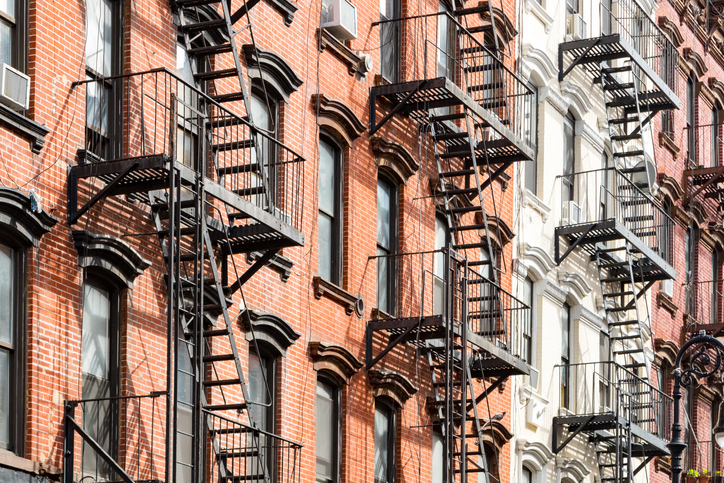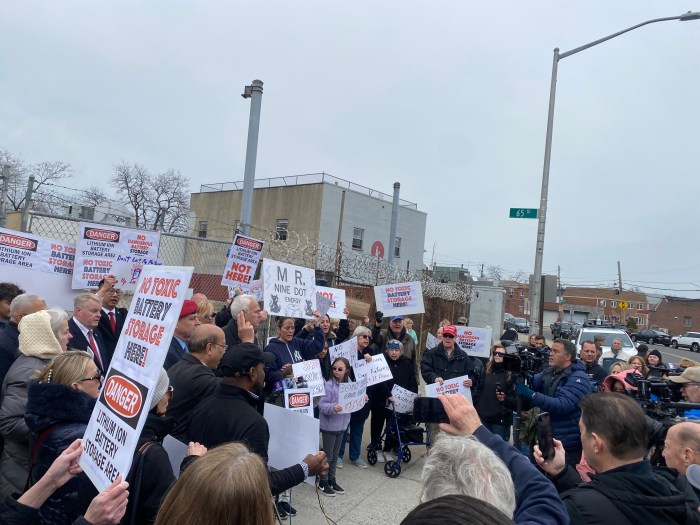By Sara G. Levin
Even for Mabou Mines, the 37-year-old experimental theater troupe whose directors delight in exploring unknown dramatic territory, producing “Song For New York: What Women Do While Men Sit Knitting,” has been quite a challenge.
“Song for New York” premiers August 31 at the Gantry Plaza State Park in Long Island City, Queens, and was originally conceived by Mabou Mines Co-Artistic Director Ruth Maleczech as a “delayed” response to September 11. Uniting poems about each borough with music, wild bird costumes, and a set perched atop a barge in the East River, the show has already stirred up waves with the Coast Guard. Now the troupe is waiting to see what audiences will think.
“I live in the West Village on Bank Street, and at St. Vincent’s hospital, there’s this wall called the Wall of Hope and Remembrance,” Maleczech said. “I selected two of those people [who were described on the wall as missing], and said those two women’s names every day.”
Maleczech said remembering those two names eventually inspired her to create a work that celebrated women as the heart of New York. Hoping to symbolically unite all the boroughs, she had originally intended to stage a production that traveled along the New York waterways. But, as with many site-specific ideas, a promising artistic vision can become a logistical nightmare.
“It’s bigger than anything I’ve done. And it’s much harder,” Maleczech said.
“It’s kind of unorthodox to have a commercial spud barge that will have a play set on it,” said Coast Guard Lt. Matt Layman, who helped review Mabou Mines’ Coast Guard application. In order to stage the show, they had to receive permission from the Coast Guard, the F.D.N.Y., and the N.Y.P.D. Harbor Unit, and did not finalize any show dates until last week.
“They have an extensive lighting system … so we needed to know that none of that light is being shown in a way that will affect other people’s navigation,” Layman said, citing one in a myriad of the Coast Guard’s concerns. He also had to ensure that the barge was safe for a quick evacuation, and in good enough condition to sustain a large production crew.
“We’ve never produced a site-specific show before,” said Sharon Fogarty, Co-Artistic director of Mabou Mines who helped produce the work. “At first we wanted to do it in four boroughs, but just moving the barge would have been over $100,000, and we would have had to have had draw bridges raised up the Harlem River, and get permission from Amtrak.”
In addition, Fogarty added, the locations they had scouted were city parks, state parks and federal land, and it proved to be more difficult than they could manage financially, and without enough time.
So with a little compromise — the barge will be docked in Queens with views of the other boroughs — and a lot of determination, the show is going up. And in the process, Mabou Mines has united a slew of talented artists to pull it together.
The company commissioned five female writers, Migdalia Cruz, Maggie Dubris, Patricia Spears Jones, Karen Kandel and Imelda O’Reilly to create poems dedicated to each borough. Each poem is set to music composed by Grammy-winner Lisa Gutkin of the Klezmatics, and woven together with text by Nancy Groce, a curator at the Smithsonian Institution Center for Folklife and Cultural Heritage who wrote “New York: Songs of the City” in 1999.
“Historically, New York City has always been dependent on the water and docks,” Groce said, while watching a rehearsal from the barge’s dock in Staten Island. Groce is originally from New York, and was the Arts Council Folklorist for the boroughs of Brooklyn and Staten Island. According to her, each River has a very distinct personality.
“The East River is a “tidal strait” [as opposed to a real river],” she said, as the barged swayed back and forth. “That’s why the tide changes, so it’s sort of schizophrenic.”
Like the river itself, each song in the show has a different musical feel. Irish singer Susan McKeown, whose voice is deep and rich, laments a sad tune for Manhattan. LaTanya Hall injects jazz into her ode for Queens, home of Louis Armstrong. The other lead performers, Sophia Holman for Staten Island, Elisa Bocanegra for the Bronx and Simotra Houston for Brooklyn, mix up music ranging from Civil War marches to salsa and Native American sounds. Each of the songs is interspersed with entr’actes of a male chorus.
“It’s a little bit like a folk opera,” Maleczech said.
The women’s bird costumes — by young designer Irina Kruzhilina, whose costumes have appeared in shows from Moscow to Milwaukee — fold out of themselves to create origami-like shapes. The set, a scaffolding bridge, and an interactive photo booth, were both designed by OBIE-award winner Julie Archer. Before the show starts, audiences are invited to have their photo taken, and write a personal story about where they live in New York. Stories collected during the course of the show will be saved and used in an art installation in 2008, said Maleczech. The installation will be intended to resemble the walls of photos that people left of missing victims of September 11.
Maleczech giggles like a child when the scaffolding bridge set is lit for the first time in lush green and purple hues over the water. “This is such a chaotic city, and yet it seems so unified at the same time.”
SONG FOR NEW YORK: WHAT WOMEN DO WHILE MEN SIT KNITTING. A Mabou Mines Production. August 31-September 9 at Gantry Plaza State Park, 50-50 Second St., Long Island City, Queens. (212) 473-1991, maboumines.org. Seating and access to an interactive Photo Booth begins at 6:45 p.m. Performances start at 8:00 p.m. Run times: Friday, August 31, to celebrate Brooklyn, Tuesday, September 4, to celebrate Staten Island, Thursday, September 6, to celebrate the Bronx, Friday, September 7, to celebrate Queens, Sunday, September 9, to celebrate Manhattan, Rain Date: Wednesday, September 5.





































